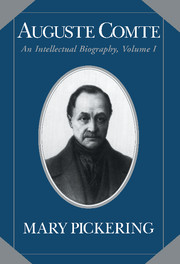Book contents
- Frontmatter
- Contents
- Acknowledgments
- Abbreviations
- Introduction
- 1 The Early Years
- 2 The Life and Works of Saint-Simon up to 1817
- 3 Comte's First Works for Saint-Simon
- 4 Comte's Growing Independence, 1819–1821
- 5 The Fundamental Opuscule and Comte's Rupture with Saint-Simon
- 6 The Aftermath of the Rupture: The Search for Connections
- 7 Comte's Efforts to Establish Himself
- 8 Intellectual and Mental Crises
- 9 The Road to Recovery, 1828–1830
- 10 Years of Success and Confrontation, 1830–1838
- 11 Comte's Changing Psyche and Aberrant Behavior, 1838–1840
- 12 The Encounter between Two Luminaries: Comte and Mill
- 13 1842: A Turning Point
- 14 Cours de philosophie positive: Positivism and the Natural Sciences
- 15 Cours de philosophie positive: Sociology
- Conclusion
- Bibliography
- Index
9 - The Road to Recovery, 1828–1830
Published online by Cambridge University Press: 06 January 2010
- Frontmatter
- Contents
- Acknowledgments
- Abbreviations
- Introduction
- 1 The Early Years
- 2 The Life and Works of Saint-Simon up to 1817
- 3 Comte's First Works for Saint-Simon
- 4 Comte's Growing Independence, 1819–1821
- 5 The Fundamental Opuscule and Comte's Rupture with Saint-Simon
- 6 The Aftermath of the Rupture: The Search for Connections
- 7 Comte's Efforts to Establish Himself
- 8 Intellectual and Mental Crises
- 9 The Road to Recovery, 1828–1830
- 10 Years of Success and Confrontation, 1830–1838
- 11 Comte's Changing Psyche and Aberrant Behavior, 1838–1840
- 12 The Encounter between Two Luminaries: Comte and Mill
- 13 1842: A Turning Point
- 14 Cours de philosophie positive: Positivism and the Natural Sciences
- 15 Cours de philosophie positive: Sociology
- Conclusion
- Bibliography
- Index
Summary
Who more than we could thus appreciate all its [the Plan's] value?
Olinde Rodrigues, 1829BACK TO JOURNALISM
Although his “precarious” way of life had “powerfully contributed” to his edification, Comte now sought a financially secure position, one that would guarantee a calm, peaceful environment in which to develop his ideas and preserve his mental health. He resumed his work as a journalist and collaborated in founding the Journal du génie civil, des sciences et des arts, which first appeared on September 1, 1828. It aimed to review “all the new discoveries and all the developments that will tend to improve and simplify civil constructions.” The journal was attractive to engineers and therefore to former students of the Ecole Polytechnique. Many of Comte's friends and acquaintances were listed as collaborators. Since most of the articles are unsigned, it is difficult to gauge the extent of Comte's contribution. But in the October and November issues, he signed articles reviewing two books on docks and canals written by J. Cordier, whose Histoire de la navigation intérieure he had discussed in Le Censeur européen in 1819. Though pedestrian, his articles helped him to make ends meet.
Comte also began writing in March 1828 for Le Nouveau Journal de Paris, a liberal daily newspaper founded the year before.
- Type
- Chapter
- Information
- Auguste ComteAn Intellectual Biography, pp. 404 - 428Publisher: Cambridge University PressPrint publication year: 1993



